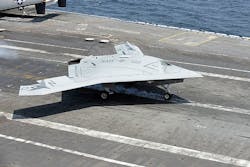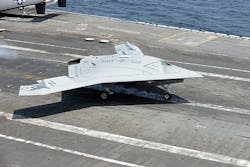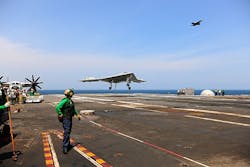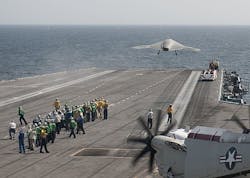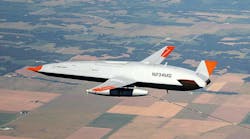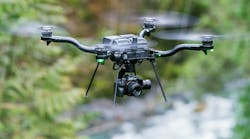USS GEORGE H. W. BUSH, At Sea (NNS), 13 July 2013. Northrop Grumman’s X-47B Unmanned Combat Air System Demonstrator (UCAS-D), a modern military unmanned aerial vehicle (UAV), completed its first carrier-based arrested landing on board USS George H.W. Bush (CVN 77) off the coast of Virginia with the help of various industry technologies, including Pratt & Whitney’s engine and exhaust system and Wind River’s software.
Pratt & Whitney's F100-PW-220U engine and exhaust system powered the first carrier-based catapult launch, touch and go, and arrested landing of Northrop Grumman's X-47B flight test aircraft for the U.S. Navy's Unmanned Combat Air System Carrier Demonstrator (UCAS-D) program.
"Achieving these milestones is exciting news for Pratt & Whitney and a major achievement for our company in demonstrating the capability and flexibility of our technology. We have worked several years with Northrop Grumman, the U.S. Navy and our industry partners to achieve these successes," says Jimmy Reed, Pratt & Whitney's director of Advanced Programs, whose team supplied the engines for the UCAS-D program. "Throughout this program, our F100-PW-220U engines have performed flawlessly and we feel proud of our product and our support of this program."
Northrop Grumman awarded a contract to Pratt & Whitney in 2008 to develop and integrate the engine and exhaust system for the X-47B. The Pratt & Whitney F100-PW-220U engine, a derivative of the F100-PW-220 and -220E engine models that power the F-15 Eagle and F-16 Falcon, enjoys the maturity gained from more than 12 million hours of operational experience. The engine and unique exhaust system have successfully completed ground accelerated mission testing. The accelerated mission test simulated the planned usage of the propulsion system during the X-47B flight test program. This endurance test demonstrated the durability and performance of the F100-PW-220U unique engine hardware and the exhaust system.
The F100-PW-220U engine is capable of providing up to 16,000 pounds of thrust and is recommended for operation in a maritime environment, including carrier deck operations. Pratt & Whitney's F100-PW-220 components and processes are common to today's F100-PW-229 and F119 and F135 family of engine technologies that allow low-risk spiral development for operational flexibility and increased fleet commonality. Pratt & Whitney is a United Technologies Corp. (NYSE:UTX) company.
Northrop Grumman also employed technology from Wind River, a provider of embedded and mobile software and a wholly owned subsidiary of Intel Corp for the catapult launch and landing of the X-47B unmanned aircraft from the deck of the USS GEORGE H.W. BUSH carrier.
The Wind River VxWorks real-time operating system (RTOS) is a key technology for the X-47B in the Navy’s Unmanned Combat Air System Carrier Demonstration (UCAS-D) program, according to a company representative.
“Wind River provides the trusted systems necessary to rapidly create, deploy, and maintain critical applications, as well as satisfy complex mission-critical requirements for next-generation intelligent systems like the X-47B,” says Chip Downing, senior director of aerospace and defense at Wind River. “Wind River is honored to be part of the UCAS-D industry team responsible for this groundbreaking military program, which is paving the way for the future of carrier-based autonomous systems technology.”
"The catapult launch and landing of the X-47B are historic milestones for the Navy, Northrop Grumman, and Wind River, whose technology has been critical to the success of this program,” adds Carl Johnson, vice president and Navy UCAS program manager for Northrop Grumman’s Aerospace Systems sector.
The X-47B is the first tailless, autonomous unmanned aircraft to be developed for carrier operations. Northrop Grumman professionals developed the unmanned aerial vehicle (UAV) for the U.S. Navy and selected VxWorks as the software platform for the UCAS-D program.
